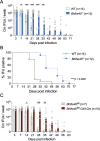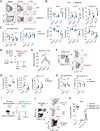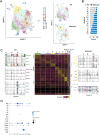BHLHE40 drives protective polyfunctional CD4 T cell differentiation in the female reproductive tract against Chlamydia
- PMID: 38271477
- PMCID: PMC10846703
- DOI: 10.1371/journal.ppat.1011983
BHLHE40 drives protective polyfunctional CD4 T cell differentiation in the female reproductive tract against Chlamydia
Abstract
The protein basic helix-loop-helix family member e40 (BHLHE40) is a transcription factor recently emerged as a key regulator of host immunity to infections, autoimmune diseases and cancer. In this study, we investigated the role of Bhlhe40 in protective T cell responses to the intracellular bacterium Chlamydia in the female reproductive tract (FRT). Mice deficient in Bhlhe40 exhibited severe defects in their ability to control Chlamydia muridarum shedding from the FRT. The heightened bacterial burdens in Bhlhe40-/- mice correlated with a marked increase in IL-10-producing T regulatory type 1 (Tr1) cells and decreased polyfunctional CD4 T cells co-producing IFN-γ, IL-17A and GM-CSF. Genetic ablation of IL-10 or functional blockade of IL-10R increased CD4 T cell polyfunctionality and partially rescued the defects in bacterial control in Bhlhe40-/- mice. Using single-cell RNA sequencing coupled with TCR profiling, we detected a significant enrichment of stem-like T cell signatures in Bhlhe40-deficient CD4 T cells, whereas WT CD4 T cells were further down on the differentiation trajectory with distinct effector functions beyond IFN-γ production by Th1 cells. Altogether, we identified Bhlhe40 as a key molecular driver of CD4 T cell differentiation and polyfunctional responses in the FRT against Chlamydia.
Copyright: © 2024 Mercado et al. This is an open access article distributed under the terms of the Creative Commons Attribution License, which permits unrestricted use, distribution, and reproduction in any medium, provided the original author and source are credited.
Conflict of interest statement
The authors have declared that no competing interests exist.
Figures






Update of
-
BHLHE40 drives protective polyfunctional CD4 T cell differentiation in the female reproductive tract against Chlamydia.bioRxiv [Preprint]. 2023 Nov 5:2023.11.02.565369. doi: 10.1101/2023.11.02.565369. bioRxiv. 2023. Update in: PLoS Pathog. 2024 Jan 25;20(1):e1011983. doi: 10.1371/journal.ppat.1011983. PMID: 37961221 Free PMC article. Updated. Preprint.
References
-
- Perry LL, Feilzer K, Caldwell HD. Immunity to Chlamydia trachomatis is mediated by T helper 1 cells through IFN-gamma-dependent and -independent pathways. The Journal of Immunology. 1997;158: 3344–3352. Available: https://www.jimmunol.org/content/158/7/3344 - PubMed
MeSH terms
Substances
Grants and funding
LinkOut - more resources
Full Text Sources
Medical
Molecular Biology Databases
Research Materials

